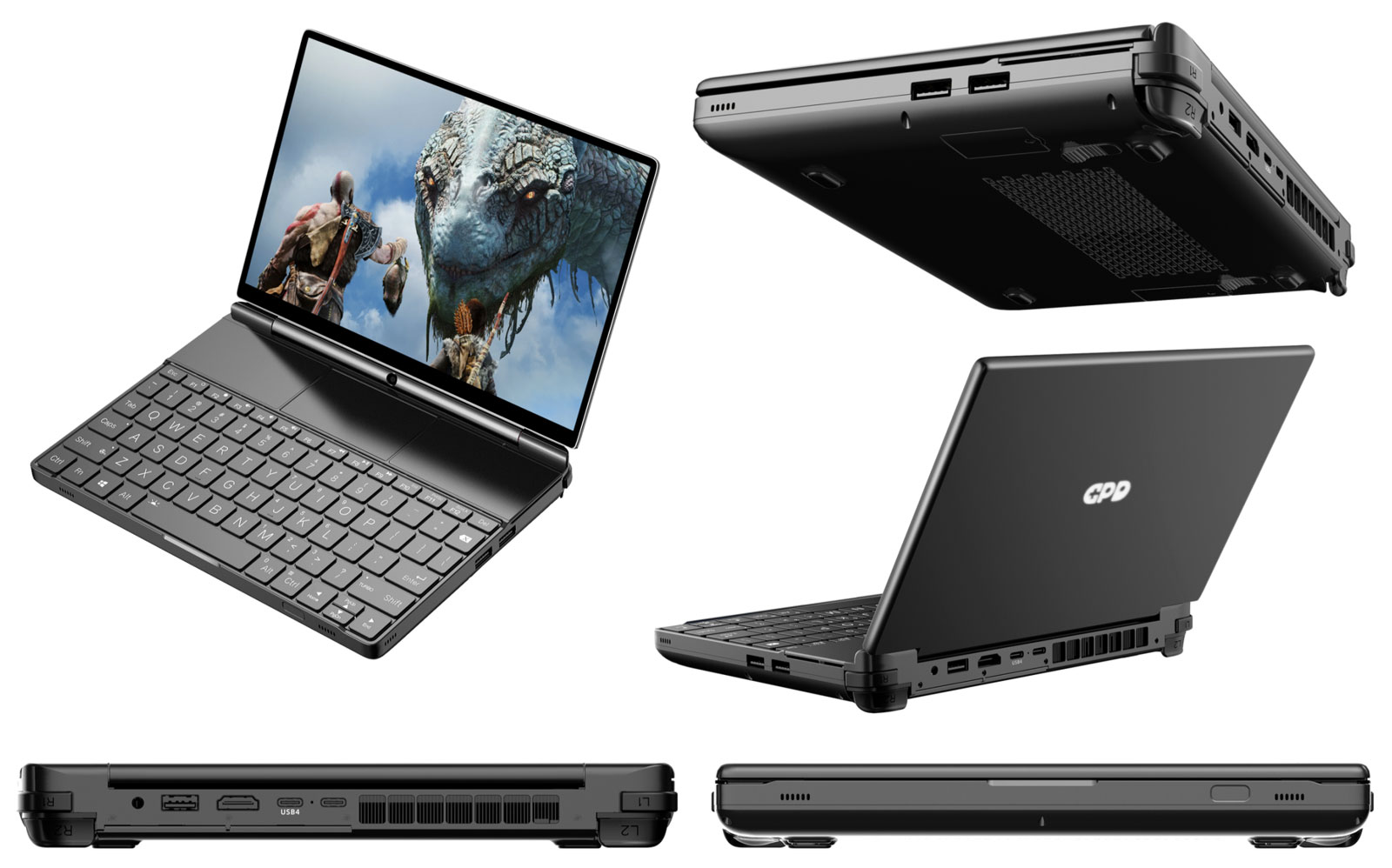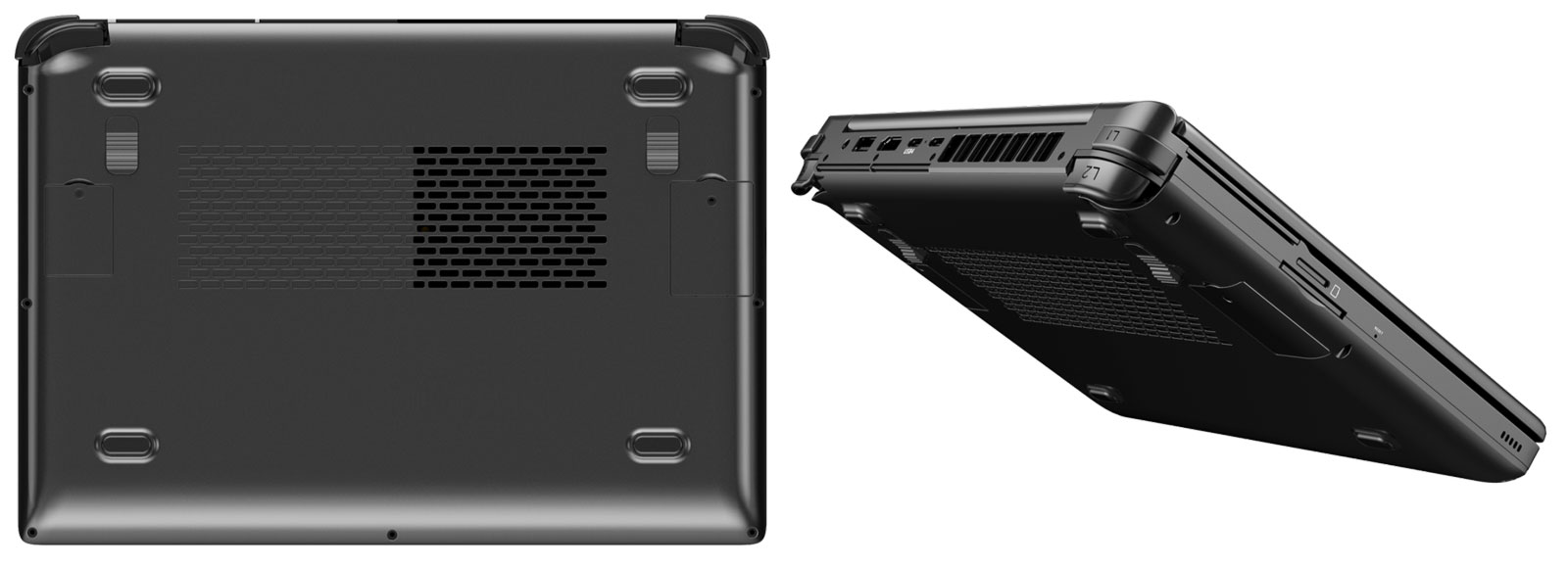AMD Ryzen 7 6800U Powered GPD Win Max 2 Confirmed
GPD shared the first details regarding its Win Max 2 clamshell portable gaming machine at the weekend. It provided a blueprint style sketch of the 10.1 inch device and a list of impressive specs, but left many wondering why there was no AMD processor option with this refresh. Today it officially revealed a version will come with the AMD Ryzen 7 6800U processor. Moreover, the Hong Kong gaming portables specialist revealed some beautiful renders of the machine from all angles.
Above and below you will find a selection of images, showing the GPD Win Max 2 in all its minimal screen bezel and integrated gaming controller glory. We get to see the controller layout, the controller covers (to provide a sleeker, more professional look), the ports, vents, and more. GPD reminds us of its announcement from the weekend that the joystick is a new hall-effect technology design, and the new 10.1 inch machine has a majority aluminium magnesium alloy build.
|
GPD Win Max 2 |
Intel 12th Gen version |
AMD Ryzen 6000 version |
|---|---|---|
|
CPU |
Intel Core i7-1280P with 14C/20T Turbo up to 4.80 GHz |
AMD Ryzen 7 6800U with Zen3+ architecture, 8C/16T, Turbo up to 4.80 GHz, |
|
iGPU |
Iris Xe G7 Graphics with 96EU, 768 stream processors. Runs at up to 1.45 GHz |
Radeon 680M RDNA2 graphics with 12CU, 768 stream processors. Runs at up to 2.2 GHz |
|
Screen |
1,920 x 1,200 pixel with ultra-narrow borders |
1,920 x 1,200 pixel with ultra-narrow borders |
|
RAM |
16GB or 32GB versions will be sold with LPDDR5 5200 MT/s RAM. Chipset supports up to 64GB |
16GB or 32GB versions will be sold with LPDDR5 6400 MT/s. Chipset supports up to 64GB |
|
Storage |
1TB or 2TB versions will be sold. The twin PCIe 4.0 M.2 slots support up to 8TB each. SD and microSD slots are present for up to a further 4TB storage. The SD slot offer up to 300 MB/s, and microSD up to 160 MB/s |
1TB or 2TB versions will be sold. The twin PCIe 4.0 M.2 slots support up to 8TB each. SD and microSD slots are present for up to a further 4TB storage. The SD slot offer up to 300 MB/s, and microSD up to 160 MB/s |
|
Ports |
Thunderbolt 4, 3x USB 3.2 Gen 2, |
USB 4, 3x USB 3.2 Gen 2, |
|
Multimedia |
Built-in web cam, quad speaker surround sound |
Built-in web cam, quad speaker surround sound |
|
Keyboard |
QWERTY keyboard with backlight and OC key |
QWERTY keyboard with backlight and OC key |
|
Gaming control |
Sunken joystick using hall-effect tech, clickable joystick, motion controls, shoulder triggers, two other keys |
Sunken joystick using hall-effect tech, clickable joystick, motion controls, shoulder triggers, two other keys |
|
Other |
4G LTE, 65 Wh battery, fingerprint login |
4G LTE, 65 Wh battery, fingerprint login |
Your choice of processor will be an important one. The Intel Alder Lake-P chip has a 28W Base Power but can consume up to 64W at peak. This processor choice will deliver 1080p gaming of modern AAA games at 60fps, according to GPD's testing. It doesn't specify quality settings, or name any specific games at this time. Furthermore, it doesn't mention the use of any frame rate boosting super sampling technologies.
Looking at the AMD option, the Ryzen 6000 chip will consume up to 28W. The mini systems maker reckons that, in the same games as the Intel machine, users should expect AMD-powered 1080p performance between 45-60fps.
Beyond the obvious processing differences, GPD has done well to minimise the disconnect between its Intel and AMD SKUs. Working through the comparison chart above the only other differences you will find is the inclusion of Thunderbolt 4, with the AMD device offering USB 4 in its place, and the difference in DDR5 RAM module speeds supplied.
Remember, both connectivity standards are based on the same underlying protocols and Thunderbolt 4 hosts support all USB 4 and Thunderbolt 3 devices. The minimum spec for USB 4 is lower, but GPD asserts that its USB 4 (AMD) portable supports all the external graphics docks you might use with the Thunderbolt 4 (Intel) version. For a full breakdown regarding Thunderbolt 4 and its differences to USB 4 and Thunderbolt 3 and other solutions please read our in-depth article dubbed What Is Thunderbolt 4?
GPD still hasn't come forth with any hints regarding release date or pricing. Now we have most if not all the specs, those are the most crucial pieces of information we would like to find out.
Get Tom's Hardware's best news and in-depth reviews, straight to your inbox.

Mark Tyson is a news editor at Tom's Hardware. He enjoys covering the full breadth of PC tech; from business and semiconductor design to products approaching the edge of reason.

